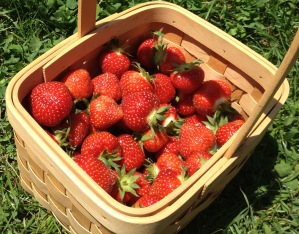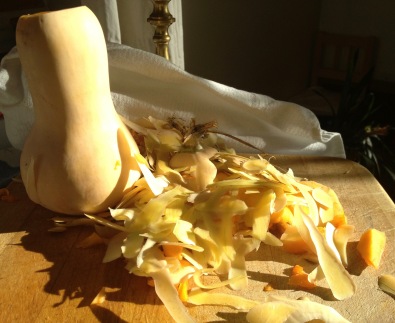When I was a teacher I told this story every autumn. After hearing this tale, students from my classes startled their families by announcing that the Pilgrims were not part of the first thanksgiving in America.

This story is a mix of legend and history. It underscores the fact that Native tribes lived in America for thousands of years before the arrival of Europeans.
The story of the Five Thanksgivings that Native Americans in Southeastern New England celebrated each year for hundreds or perhaps thousands of years before ever seeing a European was recorded by Princess Redwing (1896–1987), a Native American leader known for her wisdom and her storytelling. Her father was Narragansett and her mother was Wampanoag. “Princess Red Wing” was born Mary E. Glasko on March 21, 1896 in Sprague, Connecticut[1] to Walter and Hannah Glasko (née Weeden). She said that her mother chose to call her Princess Red Wing after the red-winged blackbird “to fling her mission far with grace” ( from Wikipedia)
The fifth of the five thanksgivings described by Princess Redwing is the harvest thanksgiving that is linked to the late November national holiday in the USA. She mentions the original shared meal of the Wampanoag and Pilgrims in a way that appears to align with the common misperception that this event was a time of shared friendship and simple gratitude.
What I like about Princess Redwing’s story is that it shows the mood of gratitude that her people carried into each season. It brings an awareness of the traditional ways of the Wampanoag and the sense of gratitude for the natural world that they held long ago and to this day.
As you prepare to tell your children or your students about the national holiday, I hope you will plan to tell them this story. When you get to the last part, the harvest thanksgiving, I hope you will offer additional age-appropriate information about the Wampanoag and Pilgrim gathering that is based in truth rather than myth.
You might say this to younger children.
The European settlers came to the land of the Wampanoag hundreds of years ago and, while some were friends, many were unkind. The Wampanoag people and other tribes who have lived here for thousands of years have much to teach about how to care for the earth. The time has come to learn from them and to become their true friends.
You might do some reading to prepare to tell older children a fuller story of the history of relations between colonists and Native Americans. This account written by Paula Peters, a journalist, educator, activist and member of the Mashpee Wampanoag tribe provides a fact based history lesson that can inform what you tell children. https://www.capecodtimes.com/in-depth/news/2020/11/19/tisquantum-squanto-wampanoag-translator-true-story/6261368002/
You could also include information about The National Day of Mourning.
“Since 1970, Indigenous people & their allies have gathered at noon on Cole’s Hill in Plymouth to commemorate a National Day of Mourning on the US Thanksgiving holiday. Many Native people do not celebrate the arrival of the Pilgrims & other European settlers. Thanksgiving Day is a reminder of the genocide of millions of Native people, the theft of Native lands and the erasure of Native cultures. Participants in National Day of Mourning honor Indigenous ancestors and Native resilience. It is a day of remembrance and spiritual connection, as well as a protest against the racism and oppression that Indigenous people continue to experience worldwide.” this quote is from the website of the United American Indians of New England: http://www.uaine.org
Here is a link to interviews with Wampanoag elders about how to tell the thanksgiving story to your kids. https://www.today.com/parents/how-tell-thanksgiving-story-your-kids-t200911
I like the idea of children learning about human history in North America by hearing about a long era when indigenous people lived in tribes across the continent. This was long before European colonists arrived. The story of The Five Thanksgivings brings children into that era. However, the fifth Thanksgiving described in the story is set in the 1600s after the arrival of the Pilgrims.
Consider saving any information about colonists until a day or more after imagining life as a Wampanoag child long before the collision of cultures. Take inspiration from this story and go outside with your children and share with them your gratitude for the natural world.
The Five Thanksgivings
a story from an audiotape recorded by Princess Red Wing transcribed and edited with explanatory additions by Kim Allsup
 The first thanksgiving ceremony came in late winter as the snow was melting. That’s when we thanked the Great Spirit for the maple trees that give the sweet syrup.
The first thanksgiving ceremony came in late winter as the snow was melting. That’s when we thanked the Great Spirit for the maple trees that give the sweet syrup.
There was always some clean snow back in the woods. We children would find birch bark and twist it into a cone and fasten it with a split stick. We filled these cones with clean snow and our fathers poured warm maple syrup over the snow. We didn’t have ice cream, but that was our delicacy.
Our second time of thanksgiving came in the late spring. One day a brother and a sister quarreled and each stomped off in opposite directions. The brother walked west with the sun in his face and the girl walked east with the sun on her back. The boy became sorry they had fought, so he asked the Great Spirit to turn him around. The girl also felt sad that she had quarreled with her brother and she wanted to bring him a peace offering. The Great Spirit told her to look down at all the bright red berries. She filled her basket with them and brought them to her brother. Today when we celebrate the Thanksgiving for the strawberries it is always a time for forgiveness and we sing this song:
“We have gathered the strawberries, come and feast to your heart’s content. Give me a pat on the shoulder friend and all our troubles will end. Hey ya hey ha hey ya hey ya.”

The third thanksgiving came in mid-summer. One day a boy was walking by a brook and he saw a canoe coming toward him. It was the smallest canoe he had ever seen. In that canoe was a tiny man who held a bow and arrow. The little man said to him, “I’ll trade my bow and arrow for your bow and arrow.” The boy said, “no, your bow and arrow is too small” and he ran back to the village to tell the people what he had seen. His grandmother said,” Never refuse anything offered to you because it is too small.”
The boy saw the little man again and this time he did trade his bow and arrow. But, the little man said ” because you refused my bow the first time, go home and tell your people to pick the green beans and eat them.” The boy replied, “but the beans are so tiny, there are only the green pods.”

You see, in those days, beans were always left on the vine to dry and the green pods were not eaten. The boy gave his grandmother the message from the little man and she told the medicine man and medicine man told the sachem. The drums began to beat. All the people sat in a circle. The sachem said Ho! The little people have spoken! Go and pick the green beans.” All the women went to the fields and filled their baskets with beans. They cooked the green beans and ate them and found them to be nutritious even though the beans inside were still very small. Ever since then we have been thanking the Great Spirit for the green beans.
The Great Spirit gave us a berry. He used all the sweetness on the raspberries, strawberries and black berries and fruit, so the cranberry is just a little sour. But we gather the cranberries just the same and make our cranberry juice and cranberry sauce and Indian cranberry bread. And, on the first Saturday in October, we thank the Great Spirit for the cranberries.

The fifth Thanksgiving of the year was the Thanksgiving for the harvest and was celebrated each autumn. In the year 1621 Squanto said to Governor Bradford, “When things look dark and your crops are poor, that’s the time for the biggest feast of all to show your Creator that you are not complaining about your hard lot.” Governor Bradford agreed saying, “We will feast and we will give thanks for what blessing we have.” So the Wampanoags came with wild turkeys, deer meat and bear meat, and beans, squash, pumpkins, melons and cranberries.

And the Wampanoags and the Pilgrims gave thanks for the harvest and enjoyed a feast together.
May we feel gratitude for the gifts of the earth throughout the year:
in late winter when the maple syrup flows
in early spring when the strawberries ripen
in mid-summer when the green beans are picked and
in early autumn when the cranberries turn red.
And in late autumn as we appreciate the bounty of the harvest.
Now you are ready to tell this story at your Thanksgiving table about the hundreds (and likely thousands) of years of seasonal celebrations of gratitude on this continent before the arrival of people from Europe. You can get everyone’s attention with this question, “Did you know that the pilgrims did not participate in the first thanksgiving in America?”
***
This story was transcribed and interpreted by Kim Allsup, a teacher, and the author of A Gift of Wonder, A True Story Showing School As It Should Be.

Absolutely lovely!
LikeLike
Reblogged this on Growing Children.
LikeLike
Kim, thank you for sharing this do you have a source for the story? I’d like to learn more.
LikeLike
I stopped reading at the word “squaw”. That is an offensive, derogatory term for a Native woman. 😦
LikeLike
I would ordinarily think that too. But this was a direct quote from Princess Redwing, then an elder of the Narragansett tribe.
LikeLike
Wonderful! I will share!
LikeLike
Thanks, Bev!
LikeLike
I thought the same thing; the term “squaw” is derogatory. But the story is supposed to have come from a native woman who was named Princess Redwing, and I have heard from native sources that there were no princesses; that it is not an indigenous title. Aside from these two things, the story is full of good teachings
and memorable images.
LikeLike
It turns out that Princess Redwing’s mom gave her that name, sort of as a nickname I think as her birth name was Mary Glasko. The title princess was not conferred by her tribe. I have changed squaw to squa to reflect the word for woman used in the Algonquin languages. See the new discussion of this in the intro to the story.
LikeLike
And it is also a word for woman in the Algonquin languages that Princess Redwing spoke. My guess is that she spoke out of her local tradition rather than broader English meaning of the word. I have added a note at the start of the story about this.
LikeLike
Beautiful.
LikeLike
Lovely rendition of Giving Thanks Ceremony seasons. I have been teaching these traditions for many years yet had not heard of Redwing. Thank you for giving voice to her. I appreciate being in relationship to her after all these years. BTW I tell families traditional, indigenous stories to celebrate the harvest of each food as we gather at our local farms. It is a lovely way to appreciate the First Nations who have respectfully foraged and cultivated the Lands we both inhabit.
LikeLiked by 1 person